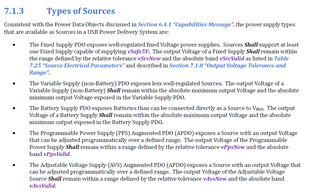Tool/software:
We will use USB PD as an adjustable power supply, up to 240W, i.e. sink only.
Basically this is what we want to do.
1. Read source capability, store in MCU
2. MCU will continuously request voltage and current based on capability. Can be fixed, PPS or AVS.
It would seem quite straight forward, but I do have some questions.
1. Do I use "Dead Battery Configuration" AlwaysEnableSink or SafeMode? From datasheet table 7-6 it seems like I should use AlwaysEnableSink when using an external MCU.
2. I will not need a EEPROM, I will upload configuration from the MCU through I2Ct at boot, it is possible from what I understand? I am a bit confused about the address, datasheet 7.3.11.1.2 said "once the boot process is complete, the port has a unique address set by ADC", is there a different address to send configuration?
3. Do I need to connect the I2Cc from TPS26750 to the MCU, if so why? I see it is connected in the evaluation board.
4. I will read/write registers through I2Ct at the address set by ADC, correct?
5. In order to read USB PD source capability, all I have to do is to read register 30h, or do I first have to send GSrC?
6. In order to change the desired voltage/current, all I have to do is to write to register 37h?
Thanks,
/Richard


